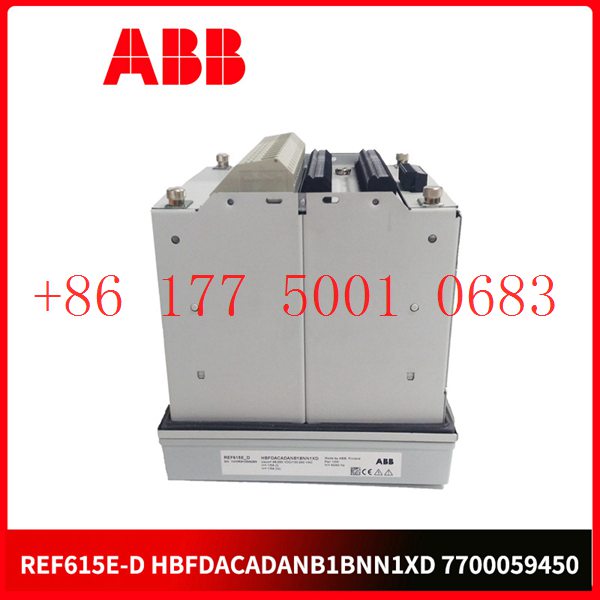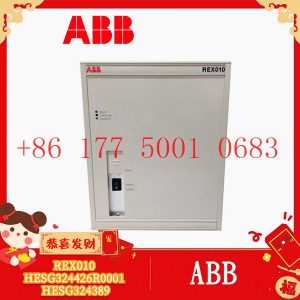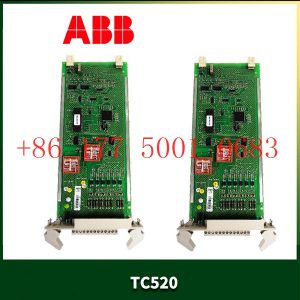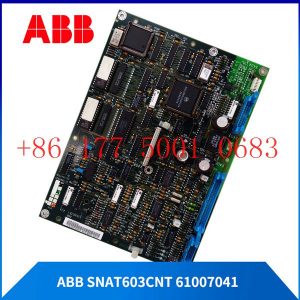Description
hardware flow control. It is an ideal choice in the field of industrial automation.
Implementation of communication between ABC industrial robot and PLC based on DeviceNet fieldbus technology
introduction
In modern production systems, industrial robots and PLCs need to communicate and collaborate to complete production tasks. That is, the
industrial robots output signals to the PLC, allowing the PLC to control related equipment to drive the robot”s front-end tools. This article
mainly analyzes the communication problems between ABB industrial robots and PLC based on DeviceNet fieldbus technology.
DeviceNet is a common network communication method in the field of automation. ABB industrial robots establish a network to communicate with
Siemens PLC based on the DeviceNet network.
1Configure DSQC652
There are mainly 5 types of standard I/0 boards commonly used in ABB industrial robots [2]. Except for the different addresses assigned to
them during setup, their configuration methods are basically the same. This article mainly analyzes the ABB standard I/0 board DS0C652, which
mainly builds communication modules based on the DeviceNet network. The DS0C652 board has a distributed I/O module with 16 digital input and 16
digital output interfaces. The board is installed in the ABB industrial robot control cabinet. First, define the specific operation steps of the DS0C652 board,
enter the teach pendant control panel, then enter the configuration menu (Figure 1), select the DeviceNetDevice menu, and add a template to enter Figure 2.
ABB standard I/0 board is hung on the DeviceNet
network, so the address of the module in the network must be set. The jumpers 6 to 12 of terminal x5 are used to determine the address of the module.
The available address range is 10 to 63. Modify the parameters in the template parameters to complete the DS0C652 board settings. Click the drop-down
menu to select the “Use value from template” row, select
“DS0C65224VDCI/0Device”, and then the parameters that need to be set include the address of the I/0 board in the bus.
Figure 1 Configuring DSQC652
2Configure signals and parameters
After completing the DS0C652 board setting, the I/0 signal setting will be performed. Setting the I/0 signal is the basis for establishing communication with
the PLC. The PLC communicates and transmits data with the ABB industrial robot through the I/0 signal and the DS0C652 board. As shown in Figure 3, in the
signal configuration interface, there are many default I/0 points after the system is established. Modification is not allowed. Click “Add” to add signals. When setting
input and output signals, their address range is 0~15. First, enter the signal menu in the configuration options to set the input and output types, and modify the corresponding parameters.
After completing the settings, the computer prompts that you need to restart the settings. If there are multiple signals that need to be defined and the waiting time
is long after restarting multiple times, you can click “Cancel” and wait for all signals to be defined before clicking the “Yes” button to restart. After the signal settings are
completed, click to select “Input and Output” in the ABB menu to check whether all signals have been set.
Figure 2 Configure DSQC652 parameters
Figure 3 Signal parameter settings
During the signal establishment process, attention should be paid to the DSoC652 port and PLC port addresses used, and the corresponding address table should be
established, as shown in Table 1. The robot interacts with the PLC through I/O signals. During the setting process, there must be no errors in the port and address number
of the PLC connected to the DSoC652. If the address is set incorrectly, the communication between the robot and the PLC will not work properly.
The entire robot teaching pendant setting process is shown in Figure 4.
Display operation panel DSIC111
Display operation panel DSI22
Display operation panel DSHM302
Display operation panel DSHM301
Display operation panel DSHM130
Display operation panel DSHM110
Display operation panel DSHM101
Display operation panel DSGC323
Display operation panel DSFS3001
Display operation panel DSFB112
Display operation panel DSF03SN-S
Display operation panel dse8610
Display operation panel DSDX-B001
Display operation panel DSDX454
Display operation panel DSDX453
Display operation panel DSDX452L
Display operation panel DSDX452
Display operation panel DSDX452
Display operation panel DSDX452
Display operation panel DSDX451L
Display operation panel DSDX451
Display operation panel DSDX404
Display operation panel DSDX404
Display operation panel DSDX403
Display operation panel DSDP451 57160001-X
Display operation panel DSDP301 57160001-LB
Display operation panel DSDP170/57160001-ADF
Display operation panel DSDP170 57160001-AOF
Display operation panel DSDP170 57160001-ADF
Display operation panel DSDP170
Display operation panel DSDP170
Display operation panel DSDP170
Display operation panel DSDP160
Display operation panel DSDP150 57160001-GE
Display operation panel DSDP150
Display operation panel DSDP150
Display operation panel DSDP140C 57160001-MP
Display operation panel DSDP140B 57160001-PU
Display operation panel DSDP140B 57160001-ACX
Display operation panel DSDP140B
Display operation panel DSDP140B
Display operation panel DSDP140A 57160001-KM
Display operation panel DSDP140A 57160001-ACT
Display operation panel DSDP110 57160001-DV
Display operation panel DSDON001
Display operation panel DSDO308 57160001-LV
Display operation panel DSDO305 57160001-CG
Display operation panel DSDO304 57160001-U
Display operation panel DSDO303 57160001-CS
Display operation panel DSDO301 57160001-CC
Display operation panel DSDO301
Display operation panel DSDO140 57160001-DO
Display operation panel DSDO131 57160001-KX
Display operation panel DSDO131
Display operation panel DSDO120 57160001-AX
Display operation panel DSDO120 57160001-AK
Display operation panel DSDO115A 3BSE018298R1
Display operation panel DSDO115A
Display operation panel DSDO115 57160001-NF
Display operation panel DSDO110 57160001-K
Display operation panel DSDO110
Display operation panel DSDI454 57160075-Y
Display operation panel DSDI453 57160075-AB
Display operation panel DSDI452 57160075E
Display operation panel DSDI452
Display operation panel DSDI451 57160075A
Display operation panel DSDI451
Display operation panel DSDI306 57160001-CM
Display operation panel DSDI304 57160001-DB
Display operation panel DSDI303 57160001-CX
Display operation panel DSDI301
Display operation panel DSDI146 3BSE007949R1
Display operation panel DSDI120AV1
Display operation panel DSDI120
Display operation panel DSDI110AV1/3BSE018295R1
Display operation panel DSDI110AV1 3BSE018295R1
Display operation panel DSDI110AV1
Display operation panel DSDI110AU1
Display operation panel DSD036S65U4031
Display operation panel DSCS150









Reviews
There are no reviews yet.